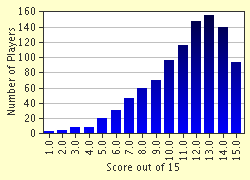Quiz Answer Key and Fun Facts
1. What was the name of the American project to create an atomic bomb?
2. In the summer of 1940 the German High Command drew up plans for the invasion of Britain. What was the code name for this operation?
3. The German invasion of Russia was codenamed?
4. The Allies tried to fool the Germans into believing that they were going to invade France through the French port of Calais. To this end they built elaborate fake installations in the Dover area of south-east England. What was the code name given to this operation?
5. The D-Day landings marked the start of which operation?
6. On September 8th, 1943 General Mark Clark led the US 5th Army on this invasion of the Italian mainland, code named?
7. What was the name of the pivotal Naval battle fought between the USA and Japan off the north east coast of Australia in May 1942?
8. What was the code name for the allied assault on Arnhem in the Netherlands on September 17th, 1944, depicted in the movie 'A Bridge Too Far'?
9. What was the name given to the last major German offensive of World War II on the Western Front?
10. What Australian city was bombed more heavily than Pearl Harbour?
11. What was the name of the decisive naval battle, in June 1942, that saw the destruction of a major part of the Japanese fleet?
12. In 'Operation Thunderclap' on February 13-15 1945 the RAF and US Army Air Force devastated a major German city. Which was it?
13. From July 1942 to January 1943 Australian troops fought a bloody battle against the Japanese along a muddy jungle trail that traversed the highlands of New Guinea. What was the name of this trail?
14. Only 3 men of a crew of 1,420 survived the sudden explosion of this British ship, engaged in a battle with the German warship 'Bismarck' on May 24th, 1941?
15. What was the name of the US warship upon which the final Japanese surrender was accepted, on September 2nd, 1945?
Source: Author
paulsr
This quiz was reviewed by FunTrivia editor
bloomsby before going online.
Any errors found in FunTrivia content are routinely corrected through our feedback system.


